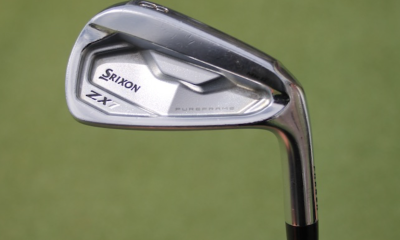Instruction
Why you are probably better at golf than you think (Part 2)

Golf is very much a monkey-see-monkey-do sport. If you ever go to the local range, you are sure to see golfers trying to copy the moves of their favorite player. Sometimes it works, and sometimes it does not. While I understand the logic of trying to mimic the “secret move” of the most recent winner on tour, I always balk when the person trying to create their best impression fails to realize the physical differences between them and the best golfing athletes in the world.
In addition to most golfers not being at the same fitness levels as the best players in the world, they also do not have bodies that are identical to their favorite player. This single statement proves why there is not one golf swing; we all are different sizes and are going to swing the club differently due to these physical differences.
You have to understand your swing
The biggest reason I believe that golfers are better than they think is most golfers I meet do not understand what their swings should look like. Armed with video after video of their golf swing, I will always hear about the one thing that the golfer wishes they could change. However, that one thing is generally the “glue” or athleticism of the athlete on display and is also the thing that allows them to make decent contact with the ball.
We are just coming out of the “video age” of golf instruction, and while I think that recording your golf swing can be extremely helpful, I think that it is important to understand what you are looking for in your swing. As a young coach, I fell victim to trying to create “pretty swings”, but quickly learned that there is not a trophy for prettiest swing.
It comes down to form or function, and I choose function
The greatest gift I have ever received as an instructor was the recommendation to investigate Mike Adams and BioSwing Dynamics. Mike, E.A. Tischler, and Terry Rowles have done extensive research both with tour-level players as well as club golfers and have developed a way to test or screen each athlete to determine not only how their golf swing will look, but also how they will use the ground to create their maximum speed. This screen can be completed with a tape measure and takes about five minutes, and I have never seen results like I have since I began measuring.
For example, a golfer with a greater wingspan than height will have a golf swing that tracks more to the outside during the backswing and intersects the body more towards the trail shoulder plane during the backswing. A golfer with a shorter wingspan than height will have a swing that tracks more to the inside and intersects the body closer to the trail hip plane. Also, a golfer with a greater wingspan than height will have a more upright dynamic posture than a golfer with a shorter wingspan than height who will be more “bent over” at the address position.
Sport coats and golf swings
Have you ever bought a sport coat or suit for a special occasion? If so, pay attention to whether it is a short, regular, or long. If you buy a long, then it means that your arms are longer than your torso and you can now understand why you produce a “steeper” backswing. Also, if you stand with your feet about shoulder-width apart and your middle-finger tips touching the top of your kneecaps, you will have perfect dynamic posture that matches your anatomy. If it appears that you are in a taller posture, then you have your second clue that your wingspan is greater than your height.
Translation to improvement
Using this and five other screens, we can help the athletes understand a complete blueprint of their golf swing based off their anatomy. It is due to the work of Mike, E.A., and Terry that we can now matchup the player to their swing and help them play their best. The reason that I believe that most golfers are better than they think is that most golfers have most of the correct puzzle pieces already. By screening each athlete, we can make the one or two adjustments to get the player back to trusting their swing and feeling in control. More importantly, the athlete can revisit their screen sheet when things misfire and focus on what they need to do, instead of what not to do.
We are all different and all have different swings. There is no one way to swing a golf club because there is no one kind of golfer. I encourage every golfer to make their swing because it is the only one that fits.
- LIKE33
- LEGIT5
- WOW4
- LOL0
- IDHT1
- FLOP1
- OB2
- SHANK2
Instruction
Clement: Laid-off or perfect fade? Across-the-line or perfect draw?

Some call the image on the left laid off, but if you are hitting a fade, this could be a perfect backswing for it! Same for across the line for a draw! Stop racking your brain with perceived mistakes and simply match backswing to shot shape!
- LIKE0
- LEGIT0
- WOW0
- LOL0
- IDHT0
- FLOP0
- OB0
- SHANK1
Instruction
The Wedge Guy: The easiest-to-learn golf basic

My golf learning began with this simple fact – if you don’t have a fundamentally sound hold on the golf club, it is practically impossible for your body to execute a fundamentally sound golf swing. I’m still a big believer that the golf swing is much easier to execute if you begin with the proper hold on the club.
As you might imagine, I come into contact with hundreds of golfers of all skill levels. And it is very rare to see a good player with a bad hold on the golf club. There are some exceptions, for sure, but they are very few and very far between, and they typically have beat so many balls with their poor grip that they’ve found a way to work around it.
The reality of biophysics is that the body moves only in certain ways – and the particulars of the way you hold the golf club can totally prevent a sound swing motion that allows the club to release properly through the impact zone. The wonderful thing is that anyone can learn how to put a fundamentally sound hold on the golf club, and you can practice it anywhere your hands are not otherwise engaged, like watching TV or just sitting and relaxing.
Whether you prefer an overlap, interlock or full-finger (not baseball!) grip on the club, the same fundamentals apply. Here are the major grip faults I see most often, in the order of the frequency:
Mis-aligned hands
By this I mean that the palms of the two hands are not parallel to each other. Too many golfers have a weak left hand and strong right, or vice versa. The easiest way to learn how to hold the club with your palms aligned properly is to grip a plain wooden ruler or yardstick. It forces the hands to align properly and shows you how that feels. If you grip and re-grip a yardstick several times, then grip a club, you’ll see that the learning curve is almost immediate.
The position of the grip in the upper/left hand
I also observe many golfers who have the butt of the grip too far into the heel pad of the upper hand (the left hand for right-handed players). It’s amazing how much easier it is to release the club through the ball if even 1/4-1/2″ of the butt is beyond the left heel pad. Try this yourself to see what I mean. Swing the club freely with just your left hand and notice the difference in its release from when you hold it at the end of the grip, versus gripping down even a half inch.
To help you really understand how this works, go to the range and hit shots with your five-iron gripped down a full inch to make the club the same length as your seven-iron. You will probably see an amazing shot shape difference, and likely not see as much distance loss as you would expect.
Too much lower (right) hand on the club
It seems like almost all golfers of 8-10 handicap or higher have the club too far into the palm of the lower hand, because that feels “good” if you are trying to control the path of the clubhead to the ball. But the golf swing is not an effort to hit at the ball – it is a swing of the club. The proper hold on the club has the grip underneath the pad at the base of the fingers. This will likely feel “weak” to you — like you cannot control the club like that. EXACTLY. You should not be trying to control the club with your lower/master hand.
Gripping too tightly
Nearly all golfers hold the club too tightly, which tenses up the forearms and prevents a proper release of the club through impact. In order for the club to move back and through properly, you must feel that the club is controlled by the last three fingers of the upper hand, and the middle two fingers of the lower hand. If you engage your thumbs and forefingers in “holding” the club, the result will almost always be a grip that is too tight. Try this for yourself. Hold the club in your upper hand only, and squeeze firmly with just the last three fingers, with the forefinger and thumb off the club entirely. You have good control, but your forearms are not tense. Then begin to squeeze down with your thumb and forefinger and observe the tensing of the entire forearm. This is the way we are made, so the key to preventing tenseness in the arms is to hold the club very lightly with the “pinchers” — the thumbs and forefingers.
So, those are what I believe are the four fundamentals of a good grip. Anyone can learn them in their home or office very quickly. There is no easier way to improve your ball striking consistency and add distance than giving more attention to the way you hold the golf club.
More from the Wedge Guy
- The Wedge Guy: Golf mastery begins with your wedge game
- The Wedge Guy: Why golf is 20 times harder than brain surgery
- The Wedge Guy: Musings on the golf ball rollback
- LIKE88
- LEGIT15
- WOW6
- LOL1
- IDHT0
- FLOP4
- OB1
- SHANK8
Instruction
Clement: Stop ripping off your swing with this drill!

Not the dreaded headcover under the armpit drill! As if your body is defective and can’t function by itself! Have you seen how incredible the human machine is with all the incredible feats of agility all kinds of athletes are accomplishing? You think your body is so defective (the good Lord is laughing his head off at you) that it needs a headcover tucked under the armpit so you can swing like T-Rex?
- LIKE0
- LEGIT3
- WOW2
- LOL0
- IDHT0
- FLOP0
- OB0
- SHANK2
-

 19th Hole2 weeks ago
19th Hole2 weeks agoJustin Thomas on the equipment choice of Scottie Scheffler that he thinks is ‘weird’
-

 19th Hole2 weeks ago
19th Hole2 weeks ago‘Absolutely crazy’ – Major champ lays into Patrick Cantlay over his decision on final hole of RBC Heritage
-

 19th Hole3 weeks ago
19th Hole3 weeks agoReport: LIV Golf identifies latest star name they hope to sign to breakaway tour
-

 19th Hole3 weeks ago
19th Hole3 weeks agoBrandel Chamblee has ‘no doubt’ who started the McIlroy/LIV rumor and why
-

 19th Hole2 weeks ago
19th Hole2 weeks agoLET pro gives detailed financial breakdown of first week on tour…and the net result may shock you
-

 Equipment3 weeks ago
Equipment3 weeks agoJason Day on his recent switch into Srixon ZX5 and ZX7 Mk II irons
-

 19th Hole6 days ago
19th Hole6 days agoGary Player claims this is what ‘completely ruined’ Tiger Woods’ career
-

 Whats in the Bag1 week ago
Whats in the Bag1 week agoTeam McIlowry (Rory McIlroy, Shane Lowry) winning WITBs: 2024 Zurich Classic


























